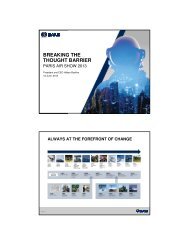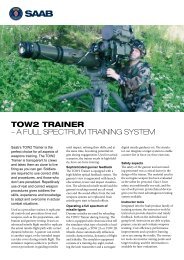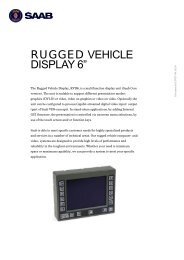ANNUAL REPORT 2009 - Saab
ANNUAL REPORT 2009 - Saab
ANNUAL REPORT 2009 - Saab
Create successful ePaper yourself
Turn your PDF publications into a flip-book with our unique Google optimized e-Paper software.
SAAB’S STRATEGIESChiefFinancialofficer, cfo+OtherCorporateFunctionsPresident and Chiefexecutive officer, ceoChief OperatingOfficer, cooChiefMarketingOfficer, CMOFunctionalManagementAeronauticsDynamicsElectronicDefenceSystemsSecurityand DefenceSolutionsSupport andServicesMarketing andBusinessDevelopmentThe global defence industry is undergoing tremendous change. In order to adapt, <strong>Saab</strong> changed the way in which its organisation is governed and structured as of 1 January 2010.The goal is to create a more market-oriented <strong>Saab</strong> with a greater focus on customers’ future requirements and needs. The organisation will also ensure good customer support, offeran even more competitive product portfolio and create further opportunities to improve operating efficiencies. <strong>Saab</strong> has restructured its former 15 business units, which were organisedin three segments, into five business areas. A new position, Chief Operating Officer (COO), has been created within <strong>Saab</strong> to which the five business areas report. To create andmaintain effective global marketing, a new Marketing and Business Development unit has been established as well.The narrower focus essentially underscores <strong>Saab</strong>’s main strategy. Theemphasis is on areas in the military and civil sectors where we haverealistic opportunities to further improve our positions, preferablyas a pioneer. Based on current market positions, this is possible primarilyin advanced aircraft, underwater systems, radar systems, civilsecurity, tactical warfare (mainly land-based), training, support andservice. A large growth potential is in the market for civil security,where <strong>Saab</strong> today has a small market share. (If you add the supervision,control and operation of global transaction systems, themarket potential is many times greater.)Leading position in critical technologiesMaintaining cutting-edge competence in critical technologies is also amajor reason for <strong>Saab</strong>’s reorganisation, which largely involves allocatingR&D resources to areas that offer the potential for leading positionsand preferably broad-based applications. The purpose of thereorganisation is to help us afford to finance expensive product innovationand maximise its commercial leverage, including faster andbroader commercialisation of new technologies.A large part of <strong>Saab</strong>’s product innovation is financed throughcustomerfinanced development projects, although we expect themto shrink in the long term. From 2000 to 2010, defense spending as ashare of Sweden’s GDP has decreased from approximately 2.1 to 1.2per cent. With regard to the procurement of materiel and equipment,as well as research and technology, expenditures havedecreased from SEK 22.3 billion (25.8 when adjusted according to netprice index) in 2000 to SEK 17.9 billion in 2010.<strong>Saab</strong> is one of Sweden’s most R&D-intensive companies. R&D asa percentage of sales in <strong>2009</strong> was 20 per cent (17), of which internallyfinanced R&D accounted for 4.8 per cent (6.4).Closer collaborations with leading universities are an importantcomponent in <strong>Saab</strong>’s R&D strategy.Efficient operationsSince a while back <strong>Saab</strong> is working on creating a more integratedorganisation. The reorganisation at the start of 2010 trimmed whathad been 15 business units with many interfaces both internally andexternally to create a more integrated company. <strong>Saab</strong> is now organisedin five distinct business areas with different offerings that arebased on the same core technologies. This will make it easier to capitaliseon functional synergies and financial resources, develop newstandardised processes and design more focused product portfolios.The new structure requires a cultural change in the company.The reorganisation is expected to generate additional co-ordinationand efficiency gains apart from those from the Billion+ Programme,which is already half completed and will be finalised in 2010.A number of new functions have been established to ensureeffective, co-ordinated actions and internal efficiencies. Some ofthese are a central marketing function with a Chief MarketingOfficer (CMO) responsible for marketing and business development,and a Chief Operating Officer (COO), to whom the five businessareas report.saab <strong>ANNUAL</strong> <strong>REPORT</strong> <strong>2009</strong> 17


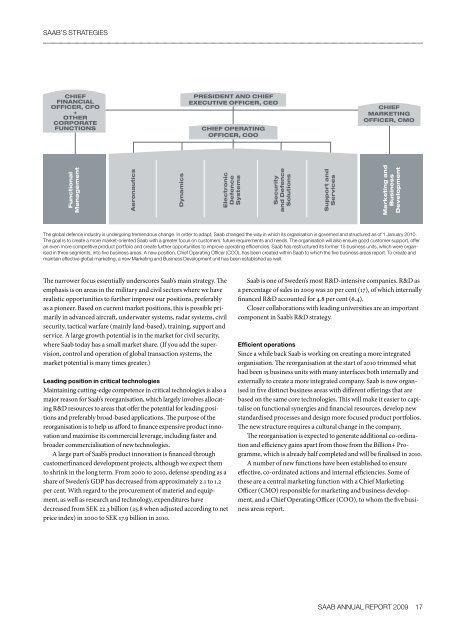

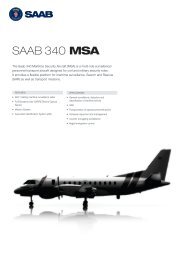
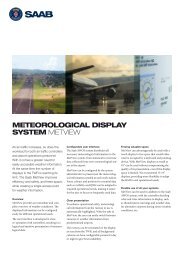
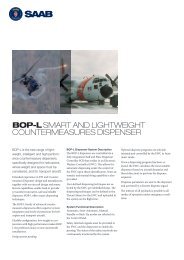

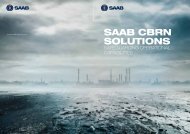
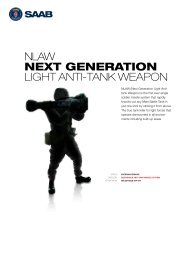
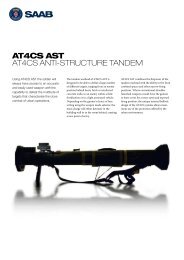

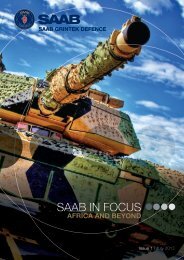
![Proposal long-term incentive programs [pdf] - Saab](https://img.yumpu.com/50411723/1/190x245/proposal-long-term-incentive-programs-pdf-saab.jpg?quality=85)
